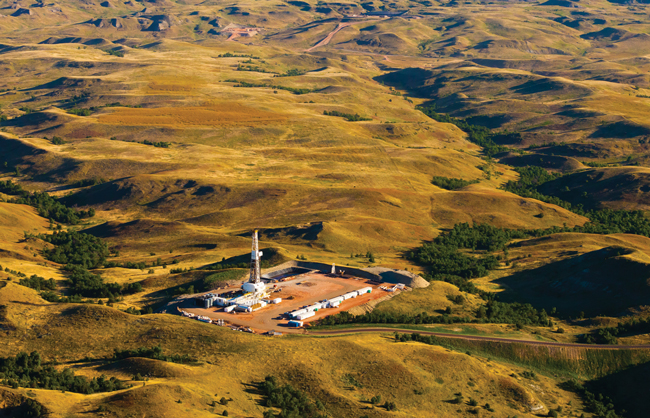
Diverse Strategies Characterize Companies Focusing On Williston Basin
By Danny Boyd
Like North Dakota’s legendary weather, the Bakken/Three Forks is a challenging environment by any measure.
But while the geology is complex and the operating challenges can be tough to deal with at times, the Williston Basin holds substantial incentive in the form of premium light, sweet crude oil reserves. That is what made the Bakken one of the first tight oil play hot spots more than two decades ago, and what continues to keep it front and center today.
Staying power in the Williston requires equal parts commitment, ingenuity and strategy. It just so happens that those are the exact qualities independents continue to display all across the basin as they implement focused operating and business plans. That includes high-grading drilling inventories, pushing lateral lengths beyond three miles, growing baseline production, testing refracturing and enhanced oil recovery methods to capture the huge upside of original oil remaining in place, and perfecting production techniques to maximize the performance of every well in the portfolio.
The Bakken/Three Forks has a little of everything in terms of operating strategies and investment opportunities. Operators range from the “original” Bakken Shale operator, Continental Resources—which in 2004 drilled the first commercially successful Bakken horizontal completed with hydraulic fracturing—to new power players such as the soon-to-be merged Chord Energy and EnerPlus, to nonoperating stalwarts such as Northern Oil & Gas and working, mineral and royalty interest aggregators such as Dakota Energy LLC.
Largest Basin Player
The pending merger of Chord Energy Corp. and Enerplus Corp. creates the largest Williston Basin player and the opportunity to reduce drilling and completion costs by exploiting a growing inventory of prospects using three-mile lateral development, says President and Chief Executive Officer Danny Brown.
Currently, 55%-60% of Chord’s inventory can accommodate three-mile laterals, and the Houston-based company expects to drill its first four-mile lateral before the end of the year. At least 10% of Enerplus’ inventory can be exploited with three-mile horizontals, although that number may be much higher pending a further assessment of those properties. Together, about 40% of current locations should fit in the category, according to Brown.
“Our combined position represents approximately 10 years of low-cost development at the current pace with significant upside beyond that,” he says.
Announced on Feb. 21 and expected to close by midyear, the merger marks the latest transaction involving larger Williston players. Chord was formed with the 2022 combination of Whiting Petroleum and Oasis Petroleum, and last year acquired 62,000 net acres from XTO Energy Inc. for $375 million. Enerplus acquired 78,700 net acres in Dunn County, N.D., from Hess Corp. in 2021. After closing, the combined company will hold 1.3 million net acres, with 98% of them in the Williston.
The pending merger of Chord Energy Corp. and Enerplus Inc. creates the largest Williston Basin operator and gives the combined company at least 10 years of low-cost development opportunities as it extends lateral lengths to three miles, and even four miles in some cases.
Post-merger, drilling and completion cost savings are estimated to be $55 million per year beginning in 2025 with a projected $150 million per year in overall synergies, the company says.
“This transaction represents a unique opportunity to drive meaningful costs and operational synergies and an improving profitability profile, and will position the pro forma business to deliver strong value creation on a sustainable basis over the long term,” remarks Ian Dundas, chief executive of Enerplus.
To make the most of the combined position, extending lateral lengths where tracts allow it will continue to be a major driver of current and projected success in some of the Williston’s premiere acreage, Brown says.
Since 2022, the two companies brought a combined 30% of the top 100 wells on line when looking at more than six months of oil production per well while turning 15% of wells in the basin to sales over that period, he points out.
In 2023, Chord made significant progress drilling, completing and cleaning out three-mile wells, Brown details. Drilling times were reduced 25%.
The company assumes that that the last mile of three-mile horizontals is typically about 80% as productive as the initial portions, but that estimate can change because of ongoing progress in clean-out times, Brown offers.
“However, it will take a little more time, likely until the end of this year, to get sufficient production histories to effectively analyze the three-mile declines and determine whether we can increase our estimated ultimate recovery uplift assumption from 140% to 150%,” he adds.
Chord has tended to prefer wider well spacing, but the combined team will evaluate conditions and consider any adjustments after the merger culminates, explains Brown.
In the fourth quarter, Chord averaged 10.3 days spud to rig release drilling three-mile laterals and logged its fastest spud-to-rig release time drilling a three-mile lateral—9.5 days—at the beginning of the first quarter, says Chord Chief Operating Officer Darrin Henke. Those drilling times are generally 1.5-2.0 days faster than Enerplus’ average times, providing the opportunity to capture efficiencies as soon as the merger culminates, he notes. Also, at the beginning of the first quarter, Chord drilled its two-mile wells in an average of 8.9 days, including one well in a record 7.4 days.
Williston Leader
Where lease configurations allow, Continental Resources is drilling three-four-mile laterals to increase capital efficiency as it extends the boundaries of Tier 1 acreage, says John Argo, vice president of Williston operations for the Oklahoma City-headquartered company.
“We are looking to maximize lateral lengths wherever we can,” he explains. “We and others are seeing more potential in areas that historically have been outside the core. We have some limitations on maximizing lateral lengths because of existing infrastructure and the way the land is already set up, but where the opportunity exists, we are pursuing. By maximizing these longer laterals and leveraging our latest development techniques, we are extending the core of the field.”
A Williston Basin leader since completing the unconventional Robert Heuer 1-17R in Divide County, N.D., in 2003, Continental continues to research how to improve recoveries from the prolific Bakken. In addition to optimizing new wells, Continental is also investing in recompletions and piloting enhanced oil recovery across its nearly 800,000-acre position.
Bakken play pioneer Continental Resources is extending lateral lengths to both redefine the boundaries of Tier 1 acreage and economically develop noncore acreage while also conducting refracturing tests and exploring potential EOR techniques that ultimately can help recover the huge amount of original oil still in place even after years of production.
In March, the company was running five rigs in Dunn County, in the heart of its lucrative core position. Still, Continental’s Williston team continues to expand its central position and develop acreage to the west in Montana, north in Divide County, and farther south, Argo says.
Continental is producing north of 200,000 barrels of oil equivalent a day in the Williston and plans to spend approximately $1 billion this year in the basin. 2024 plans include drilling and completing around 125 new wells, performing about a dozen refracs, and progressing an EOR project with a view to improving long-term recovery. Work this year follows a strong performance in 2023, according to Argo.
“Our team did a phenomenal job and broke the record for Continental’s overall total production from the Williston last year,” he comments. “This is an awesome testament to all the work our team has done as it still breaks records after Continental’s more than 20-year unconventional history here.”
Efficiencies also are improving as the company continues to build and connect water recycling infrastructure to reduce dependence on freshwater supplies. Improvements are partially driven by Continental’s conversion in late 2022 from a public to a private company, Argo says, a move that freed 20% of the team’s time to focus more on projects that maximize value.
Drilling with multiple rigs on the same pad and utilizing simultaneous fracs to speed completions are improving cycle times dramatically, he points out.
Although it is planning a dozen refracs, Argo says Continental may do more as it assesses potential recompletion designs and identifies prospects based on reservoir characteristics, estimates of OOIP, initial production and decline profiles, and original completion designs.
The company is in the early stages of testing and researching refrac designs. A Bakken well refrac can exceed $5 million compared with a new Bakken well cost of about $7 million, he reveals, but notes that efficiencies will grow as Continental and others test refrac designs in the Williston and elsewhere to maximize the value.
With more than 90% of oil remaining in place even after all the Williston development from the last 20 years, Continental—along with other companies and universities—also is researching the best EOR methods to boost yields from the Bakken and Three Forks benches, Argo reports.
“It is a big prize, and we are investing in EOR in multiple areas across our portfolio to determine how we can unlock and capture incremental barrels from existing plays,” he says.
Growing The Market
The Williston Basin’s days are far from numbered as new players seek drilling opportunities and established companies continue to add inventory through bolt-ons and M&A, says Preston Page, president of Dakota Energy LLC, an aggregator of working, mineral and royalty interests.
With 90% of proved, developed and producing reserves owned by fewer than 20 companies, the basin has become more consolidated, but newer startups continue to seek Williston positions. Some half dozen have acquired properties of late, including 5,000-20,000-acre lease packages typically assembled by Dakota Energy.
An in-house study by Dakota Energy estimates that Tier 1 acreage is growing by 5%-10% and Tier 2 acreage is growing by 20% annually across the Bakken play as operators implement development programs. Some 1.5 million of the total 7.0 million acres in the Williston Basin prospective for the Bakken remain undrilled.
“We like more players in the basin,” says Page, a member of the North Dakota Petroleum Council Board of Directors. “It brings innovation, a little bit of competition and it grows the market for everybody.”
Dakota Energy categorizes the Williston Basin’s Bakken in three tiers, which consist of nearly 7 million total acres. Inside of that perimeter is close to 1.5 million acres still undrilled—including federal lands, national parks, and other areas with more legal and regulatory impediments to exploration, he says. Still, net undrilled acreage may be close to 800,000, a sizable footprint of potential prospects that may number more than 10,000, Page notes, pointing to the findings of an in-house study.
In Dakota Energy’s opinion, the technology advancements in drilling 15,000-foot laterals greatly has expanded the footprint of what can be considered “prospective.” The company’s research shows more than 442 laterals drilled to date basinwide that are longer than 2.5 miles, he relates. Limited surface locations, including some traversed by the Missouri River, make longer laterals necessary in some locations, but the growing reach has demonstrated the viability of acreage formerly considered uneconomical.
Established companies are pushing North Dakota Tier 1 and 2 acreage into northern Williams County, southern Burke County, western Divide County and western Dunn County, he says, estimating that Tier 1 acreage is growing 5%-10% annually and Tier 2 acreage is growing by 20%.
Dakota Energy has targeted prospective acreage in areas where that extra mile of lateral adds only 15%-20% to costs but increases EURs by 35%, Page says.
“The Bakken has historically been understimulated and about 30% of it was stimulated with less than 400 pounds of proppant/foot,” he explains. “Looking at the well count and the locations of existing production does not tell the whole story of the basin’s infill potential. We do not play in that arena of buying PDP producing assets, but it leads toward a lot of expansion opportunities for us to offer operators.”
In terms of the royalty market, Page says there is substantial private mineral ownership that has driven the pace of development with 60%-65% of minerals held by fee owners. Calculations show that 100,000 private royalty owners hold an average of 45 acres each, but counting smaller interests, the number easily may exceed 200,000, he estimates. Page estimates that the royalty market in the Williston Basin is valued at more than $15 billion, and the ownership is highly diverse.
Mergers will dictate to some degree the pace of development and proving up acreage, but North Dakota’s support of the industry also is making a big difference, with the state permitting 800-plus wells annually and issuing permits faster, Page says. From permitting to sales can take fewer than six months.
“The velocity of that cash flow is as efficient as it has ever been. It is unrivaled,” he concludes. “That is what makes us so optimistic about the future of the Bakken.”
Reinventing Itself
Publicly held nonoperator Northern Oil & Gas Inc. (NOG) continues to be optimistic about prospects in the Williston as it views the basin’s ongoing evolution from a front-row seat, says company President Adam Dirlam.
As a publicly held nonoperator, Northern Oil & Gas Inc. has transacted more than $1 billion in M&A deals in the Williston Basin since 2018, growing its position to 183,640 net acres. The company recorded its highest Williston volumes ever in the fourth quarter from some 8,000 wells operated by producers such as Continental, Marathon Oil, ConocoPhillips and Slawson Exploration.
Based in nearby Minneapolis, NOG was formed with Williston assets in 2006-07 and has transacted on over $1 billion on M&A in the basin since 2018, growing its position to 183,640 net acres.
“What has been most encouraging for us, especially as the basin has matured, is how it has reinvented itself,” Dirlam says. “I give a lot of credit to operators and the innovation that we have seen across the board with completion methodologies and taking Tier 2 acreage and generating Tier 1 returns. We also continue to see consistent results with step-outs, and we are not seeing degradation in terms of capital returns and well productivity.”
In the fourth quarter of 2023, the company saw its highest Williston Basin volumes ever from 8,000 wells and counting, which are operated by the likes of Continental, Marathon Oil, ConocoPhillips, Slawson Exploration and others.
The basin contributes 46% of NOG’s overall production, projected to be as high as 120,000 boe/d this year from 10,000 gross wells on 270,000 acres operated by 100 public and private operators across the Williston, Permian and Appalachia basins.
In North Dakota, the company remains open to being an investing partner for operators seeking M&A, debt reduction or drilling capital. In 2023, NOG invested in several high-profile Permian transactions.
“I think there are going to be some opportunities where we could potentially partner with an operator where the acquisition size might be a little bit too big for them,” he says. “We can also be helpful partnering with operators and helping rationalize their portfolios post-M&A as consolidation continues.”
One benefit of being a longstanding Williston player is having access to large volumes of data on most of the basin’s wells, he goes on. The company utilizes a proprietary data science system, Drakkar, to help optimize daily operations and guide decision-making. Inputs include land, lease, unit and contract information; information from a national well database; reservoir engineering models; financial data with operator cost structure and midstream statistics; well development monitoring with information on permit and rig schedules, production and capital spending reports.
From that, NOG gets real-time data analytics to monitor well performance, operator cost structures, operator behavior and M&A activity, Dirlam relates. Williston data includes 350 type curves by area, operator, formation and county for the company’s engineering team to assess.
“We get to look under the hood of pretty much every notable operator within the Williston from the standpoint of well costs, lease operating expenses and price realizations,” Dirlam states. “We take proprietary information and marry that with publicly available data and that directs our capital allocation efforts.”
He adds that the company remains open to discussions with smaller operators, but typically realizes its best returns with larger operators taking advantage of scale and in-house expertise in the Williston and elsewhere.
For other great articles about exploration, drilling, completions and production, subscribe to The American Oil & Gas Reporter and bookmark www.aogr.com.










